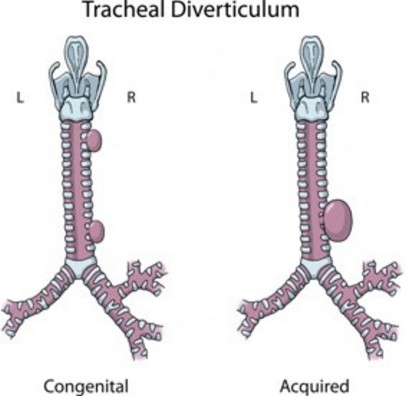Very rare. A distinction is made between congenital diverticula and acquired diverticula:
- congenital diverticulum: considered as an interrupted division of a primitive pulmonary bud (sometimes a rudimentary tracheal bronchus), it is usually located on the right side, 4 -5 cm below the vocal cords or a few cm above the carina. It is composed of the elements of the trachea (muscle, cartilage), usually directed downwards and filled with mucus. It may be associated with other tracheobronchial abnormalities.
- acquired diverticulum: this is a evagination of the tracheal mucosa through a weak point of the tracheal wall (laterally between two rings or posteriorly between the tracheal muscles). It is called tracheocele if it is located on the right side at the thoracic inlet.
A particular form of tracheal diverticulum is the tracheal remnant of an operated tracheoesophageal fistula (see esophageal atresia).

Clinical presentation: usually paucisymptomatic or asymptomatic, but it can be a source of chronic cough, hemoptysis, dyspnea or stridor. A few cases of perforation following the accidental intubation of the diverticulum have been described.
Anesthetic implications:
keep that diagnosis in mind in case of difficult ventilation after tracheal intubation, especially in a child with a history of tracheoesophageal fistula repair: severe bronchospasm (more common) or intubation of a tracheal diverticulum ?
References :
- Dinner M, Ward R, Yun E.
Ventilation difficulty secondary to a tracheal diverticulum.
Anesthesiology 1992; 77:586-7.
- Cheng AT, Gazali N.
Acquired tracheal diverticulum following repair of tracheo-oesophageal fistula : endoscopic management.
Int J Pediatr Otorhinolaryngol 2008; 72:1269-74.
- Désir A, Ghaye B.
Congenital abnormalities of the intrathoracic airways.
Radiol Clin N Am 2009; 47: 203–25
- Adhara C, Richa V, Aparna C, Nilesh S, Devendra C.
Tracheal diverticulum: rare presentation of known entity: a case report.
A&A Practice 2020; 9: e01262
- Mathew PJ, Ashok V, Malik MA.
Ventilation failure due to endotracheal tube migration into a tracheal pouch in a toddler with a repaired tracheoesophageal fistula: a case report.
A&A Practice 2020 ; 14:48-50.
Updated: August 2021